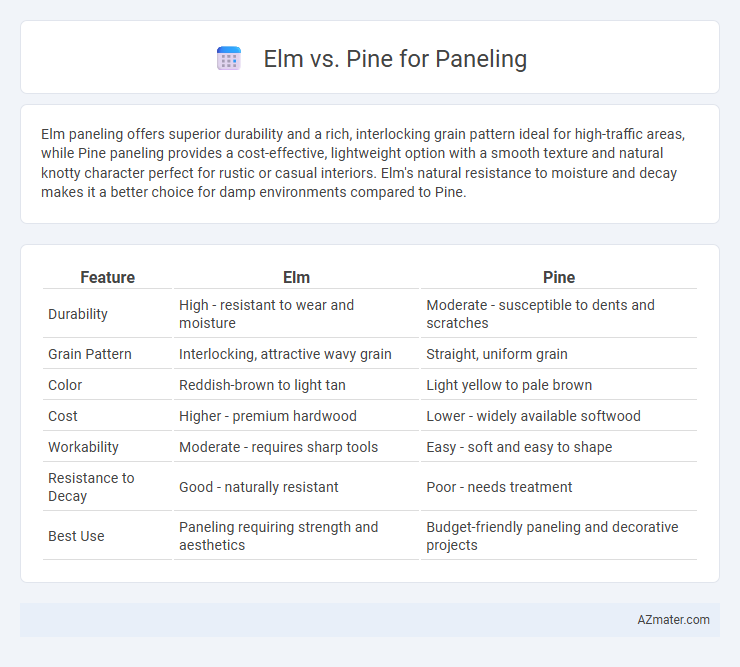Elm paneling offers superior durability and a rich, interlocking grain pattern ideal for high-traffic areas, while Pine paneling provides a cost-effective, lightweight option with a smooth texture and natural knotty character perfect for rustic or casual interiors. Elm's natural resistance to moisture and decay makes it a better choice for damp environments compared to Pine.
Table of Comparison
| Feature | Elm | Pine |
|---|---|---|
| Durability | High - resistant to wear and moisture | Moderate - susceptible to dents and scratches |
| Grain Pattern | Interlocking, attractive wavy grain | Straight, uniform grain |
| Color | Reddish-brown to light tan | Light yellow to pale brown |
| Cost | Higher - premium hardwood | Lower - widely available softwood |
| Workability | Moderate - requires sharp tools | Easy - soft and easy to shape |
| Resistance to Decay | Good - naturally resistant | Poor - needs treatment |
| Best Use | Paneling requiring strength and aesthetics | Budget-friendly paneling and decorative projects |
Elm vs Pine for Paneling: A Comprehensive Comparison
Elm wood offers superior durability and natural resistance to moisture, making it an excellent choice for paneling in humid environments, while pine is softer, easier to work with, and typically more cost-effective. Elm's distinctive grain patterns and rich, warm tones provide an elegant, rustic aesthetic, whereas pine's lighter color and uniform texture suit modern or minimalist designs. Choosing between elm and pine depends on desired durability, budget, and stylistic preferences for paneling projects.
Wood Grain and Appearance Differences
Elm wood features an interlocking grain with a coarse texture, offering a distinctive wavy or mottled appearance that adds character and warmth to paneling. Pine displays a straighter, more uniform grain with prominent knots, providing a rustic and natural look that highlights its lighter color and softer texture. The choice between Elm and Pine for paneling influences both the visual complexity and tactile feel of interior spaces.
Durability and Strength: Elm vs Pine
Elm wood is renowned for its exceptional durability and natural resistance to decay, making it a strong choice for paneling in high-traffic or moisture-prone areas. Pine, while softer and less dense than elm, offers moderate strength but is more susceptible to dents and scratches over time. The interlocking grain structure of elm contributes to greater structural integrity compared to the more uniform grain of pine, which can affect long-term performance in paneling applications.
Workability and Installation
Elm offers superior workability for paneling due to its interlocking grain structure, making it less prone to splitting during cutting and shaping. Pine paneling, being softer and more uniform, allows easier installation with standard tools but may dent or scratch more easily in high-traffic areas. Both woods provide reliable fastening options, yet elm requires slightly more effort for precise fitting, while pine ensures quicker installation with smoother surfaces.
Maintenance Requirements
Elm paneling demands regular sealing and occasional sanding to prevent warping and insect damage, benefiting from its natural resistance to moisture and decay. Pine paneling requires frequent protective coatings and vigilant pest control due to its softer wood structure and higher susceptibility to dents and scratches. Both woods benefit from dusting and avoiding excess humidity, but elm generally offers lower maintenance intensity over time.
Cost Comparison: Elm vs Pine Paneling
Elm paneling typically costs more than pine due to its denser grain and greater durability, making it a premium choice for high-end interiors. Pine paneling is more affordable, widely available, and easier to work with, appealing to budget-conscious homeowners and DIY projects. Choosing between elm and pine paneling often depends on balancing upfront material costs against long-term wear and maintenance expenses.
Environmental Impact and Sustainability
Elm wood offers durability and resistance to decay, making it a sustainable choice for paneling as it often comes from responsibly managed forests and reclaimed sources, reducing the environmental footprint. Pine, a fast-growing softwood, is widely available and commonly harvested from renewable plantations, which supports carbon sequestration and sustainable forestry practices. Both materials can contribute to eco-friendly interiors when sourced with certifications like FSC or PEFC, emphasizing responsible forest management and reduced ecological impact.
Common Uses in Interior Design
Elm wood is favored in interior design for its durability and attractive grain, making it a popular choice for rustic and traditional paneling that enhances warmth and character in living spaces. Pine, known for its light color and affordability, is commonly used in interior paneling to create a bright, natural aesthetic, often found in cabins, country-style homes, and modern farmhouse designs. Both woods are valued for their workability, but pine's softer texture allows for easier customization and painting, while elm's dense structure offers greater resistance to dents and wear.
Pros and Cons of Elm Paneling
Elm paneling offers a unique grain pattern and excellent durability, making it ideal for rustic and traditional interiors. Its natural resistance to splitting and warping enhances longevity but can be harder to source and more expensive than Pine. Elm's darker hues and rich texture provide sophisticated aesthetics, whereas Pine offers lighter color and easier workability, often at a lower cost.
Pros and Cons of Pine Paneling
Pine paneling is prized for its affordability, lightweight nature, and ease of installation, making it a popular choice for interior walls and ceilings. Its softwood composition allows for effortless staining and painting, but it is more prone to dents, scratches, and moisture damage compared to hardwoods like Elm. Pine's natural knots and grain patterns offer a rustic aesthetic, yet it may require regular sealing to prevent warping and maintain durability over time.

Infographic: Elm vs Pine for Paneling
 azmater.com
azmater.com